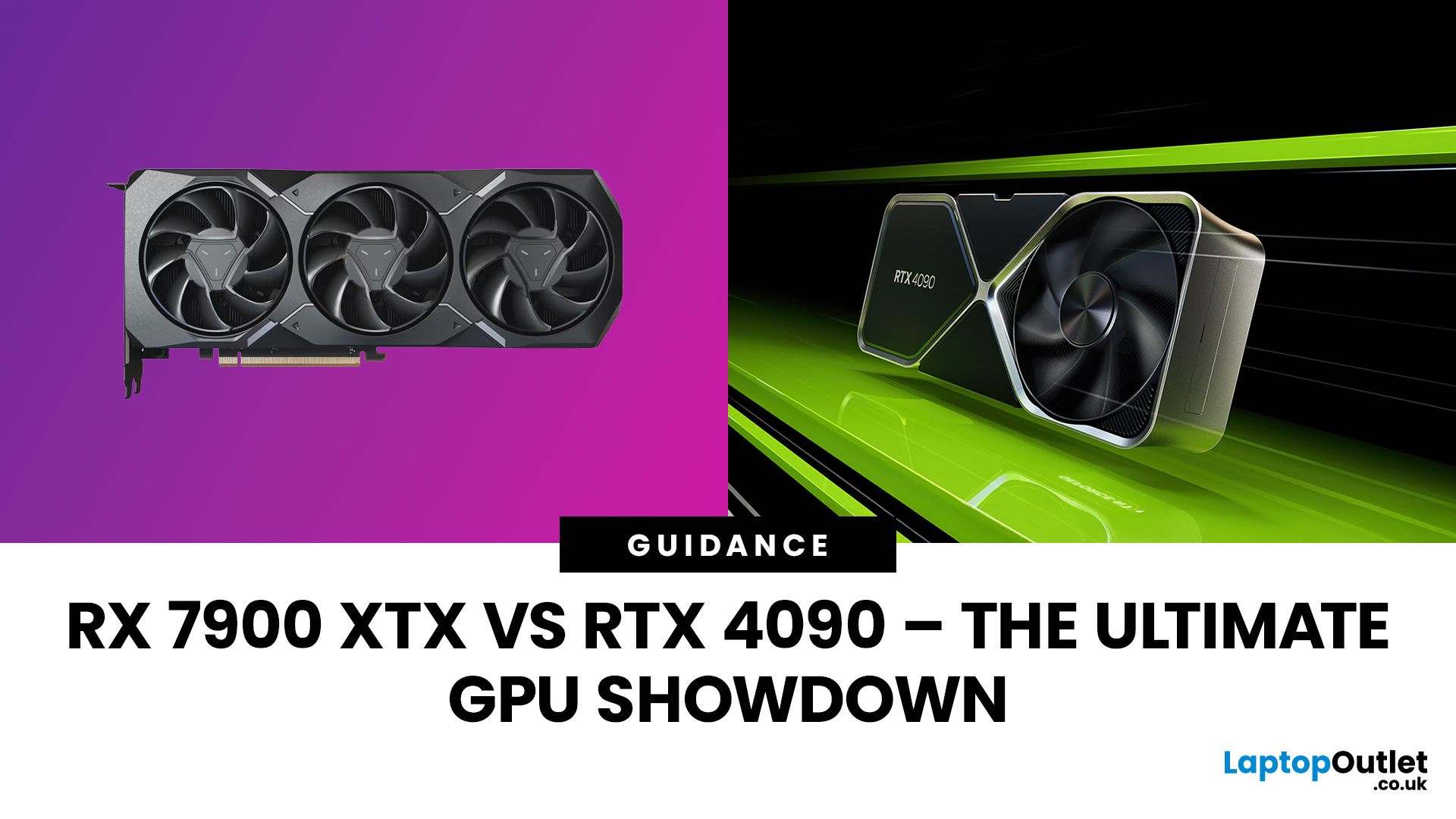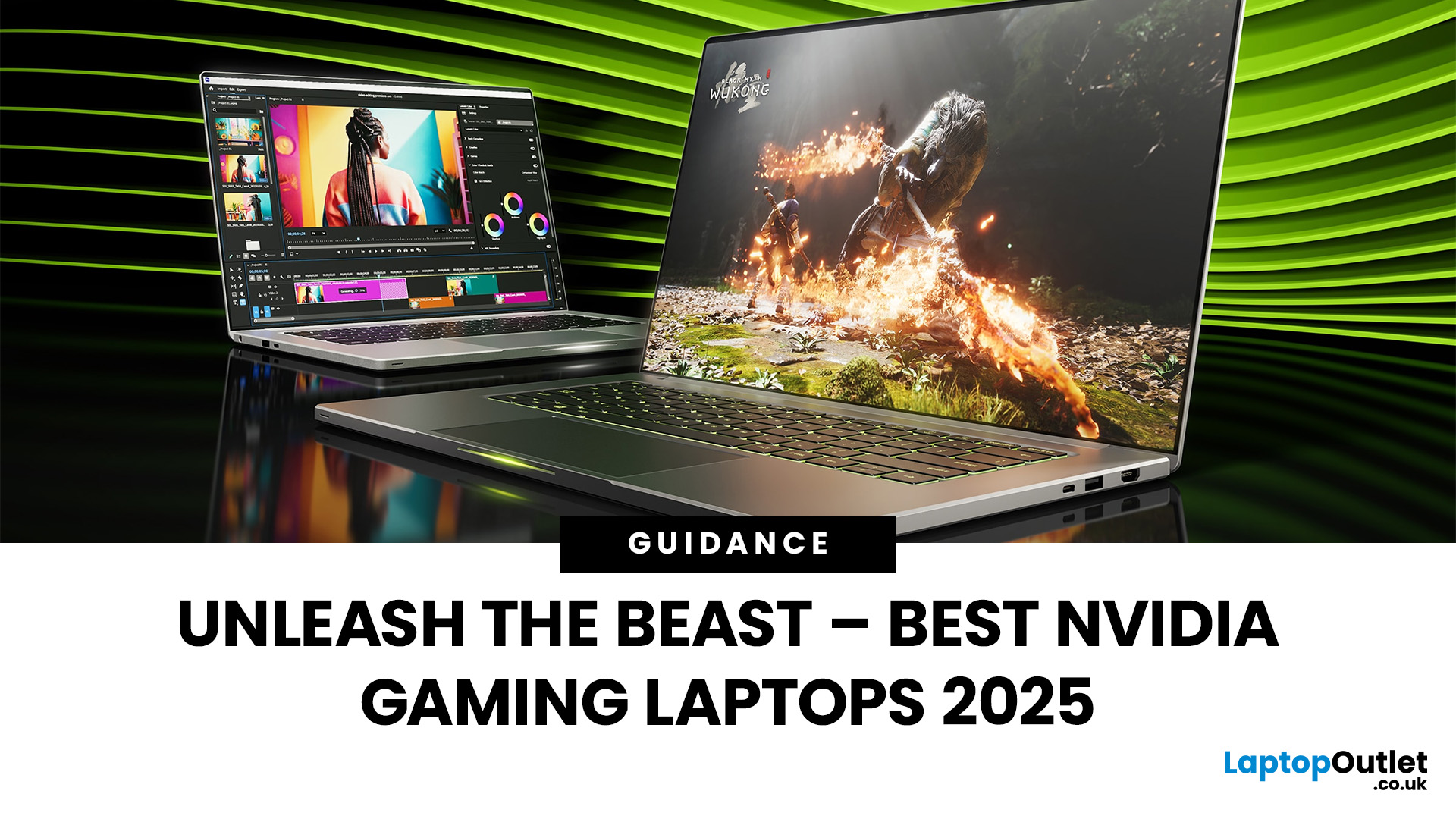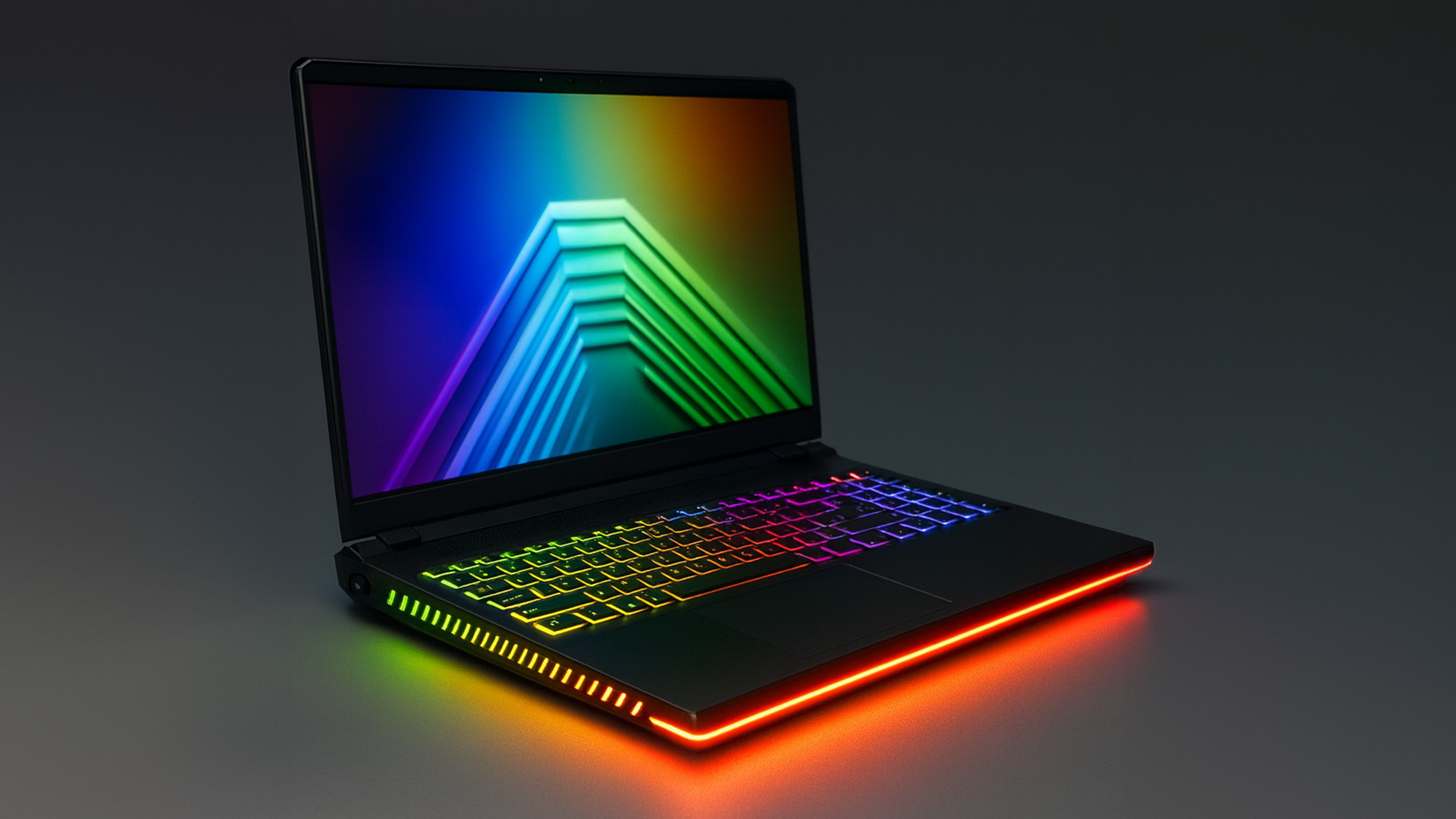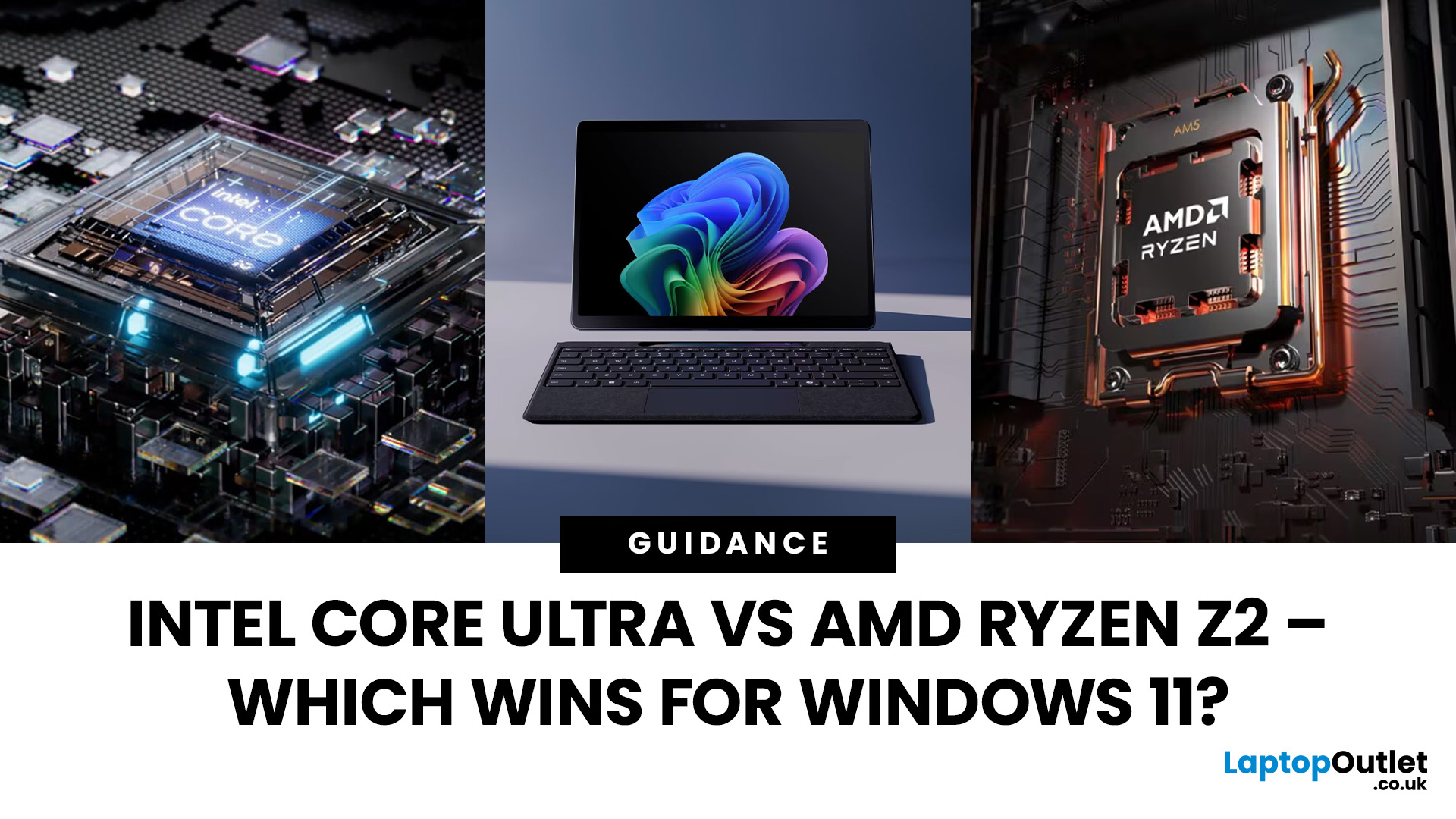AMD Radeon RX 7900 XTX vs NVIDIA RTX 4090 – Flagship Battle

The AMD Radeon RX 7900 XTX and NVIDIA RTX 4090 are 2025’s top-tier GPUs, built for 4K gaming and professional workloads. The RTX 4090 leads in raw power, ray tracing, and AI acceleration, while the RX 7900 XTX challenges it with lower cost and strong raster performance. This isn’t about branding, it’s about what delivers the best performance per pound. In this breakdown, we’ll compare specs, gaming benchmarks, ray tracing, AI workloads, thermals, and overall value to determine which flagship GPU truly dominates.
Specification Overview
Before comparing real-world performance, it’s important to see how these two GPUs differ on paper. The RTX 4090 is built on NVIDIA’s Ada Lovelace architecture, while the RX 7900 XTX uses AMD’s RDNA 3 designs. Both target 4K gaming, but their hardware layouts, power needs, and pricing tell very different stories.
|
Specification |
AMD Radeon RX 7900 XTX |
NVIDIA GeForce RTX 4090 |
|
Architecture |
RDNA 3 |
Ada Lovelace |
|
GPU Process |
5 nm + 6 nm (chiplet) |
4 nm monolithic |
|
Stream / CUDA Cores |
6,144 Stream Processors |
16,384 CUDA Cores |
|
Base / Boost Clock |
1.9 / 2.5 GHz |
2.2 / 2.5 GHz |
|
VRAM |
24 GB GDDR6 |
24 GB GDDR6X |
|
Memory Bus |
384-bit |
384-bit |
|
Memory Bandwidth |
960 GB/s |
1,008 GB/s |
|
TDP (Power Draw) |
355 W |
450 W |
|
Launch Price (UK) |
Around £999 |
Around £1,599 |
In short, the RTX 4090 delivers higher compute power and better ray tracing cores, but it also consumes more power and costs significantly more. The RX 7900 XTX offers excellent performance per pound, more efficiency, and the same generous 24 GB of VRAM, making it a strong option for high-end gamers who don’t want to overspend.
Gaming Performance at 1440p and 4K
When it comes to raw gaming power, both cards are built for 4K gaming, but they cater to slightly different audiences. The RTX 4090 is the undisputed leader in sheer performance, while the RX 7900 XTX focuses on delivering close results at a much lower cost.
At 1440p, both GPUs handle modern AAA games effortlessly, often hitting frame rates well above 150 FPS. The real test begins at 4K, where the RTX 4090 consistently outperforms the RX 7900 XTX by about 20–25% in most titles. In games like Cyberpunk 2077, Alan Wake 2, and Horizon Forbidden West, NVIDIA’s higher core count and memory bandwidth help maintain smoother frame times and fewer dips under heavy loads.
The RX 7900 XTX still delivers excellent 4K results, comfortably running most games above 100 FPS with ultra settings. It especially shines in well-optimised titles and those that rely on rasterisation (traditional rendering). For gamers using a 144 Hz 4K display, both cards deliver top-tier experiences, but the RTX 4090 holds the edge when every frame counts.
In simple terms: the RTX 4090 is faster, but the RX 7900 XTX comes surprisingly close for hundreds of pounds less.
Ray Tracing and DLSS/FSR Comparison

Ray tracing remains one of the biggest separating factors between these two GPUs. NVIDIA continues to lead here, thanks to its more mature ray tracing cores and software ecosystem. The RTX 4090 handles heavy ray-traced titles like Cyberpunk 2077, Portal RTX, and Alan Wake 2 with ease, often keeping 4K frame rates above 70–90 FPS using DLSS 3.5. This technology uses AI-based frame generation and upscaling to maintain smooth visuals without sacrificing quality.
The RX 7900 XTX, while much improved over AMD’s previous generation, still trails in this area. It performs well in lighter ray-traced workloads and can manage playable frame rates with FSR 3 (FidelityFX Super Resolution), but it's hardware simply can’t match NVIDIA’s RT core efficiency. In the most demanding ray-traced scenes, AMD’s card can lag behind by as much as 35–40%. For a broader list of options, check out our guide to the best GPUs for 4K and ray tracing gaming.
That said, FSR has one key advantage, it works across most GPUs, including older models and even NVIDIA cards. For gamers not deeply invested in ray tracing, the RX 7900 XTX still delivers impressive visuals without the premium price tag.
In short: if ray tracing is a must-have feature, the RTX 4090 dominates. But if you can live without ultra-level reflections and lighting, the RX 7900 XTX offers better value for traditional gaming.
AI, Productivity, and Compute Workloads
Outside of gaming, GPUs are increasingly used for creative and professional work - rendering, video editing, 3D modelling, and AI-based tools. Here, the RTX 4090 has a very clear advantage.
NVIDIA’s card features dedicated Tensor Cores that accelerate AI workloads, which benefits software like DaVinci Resolve, Blender, Stable Diffusion, and Adobe Premiere Pro. The RTX 4090 can process complex renders and AI image generation tasks up to two to three times faster than the RX 7900 XTX. Features such as OptiX rendering, DLSS Frame Generation, and CUDA support give NVIDIA a wide edge in content creation and machine learning workflows.
The RX 7900 XTX still performs well in pure compute or OpenCL-based applications and handles tasks like video editing or 3D design efficiently. However, AMD’s ecosystem lacks widespread software optimisation compared to NVIDIA’s CUDA framework. For professionals relying on AI-driven programs or GPU-based rendering, the RTX 4090 remains the practical choice. If content creation is your focus, here are the top GPUs for 3D rendering, video editing & streaming.
In short: for productivity and AI acceleration, the RTX 4090 is in a league of its own. The RX 7900 XTX is capable, but its strength remains primarily in gaming rather than creative or AI workloads.
Power Efficiency and Thermals

Power and cooling are key factors when choosing a high-end GPU, especially for long gaming or rendering sessions. Both the RX 7900 XTX and RTX 4090 are demanding cards, but they differ noticeably in how they manage heat and power.
The RTX 4090 has a 450W TDP, making it one of the most power-hungry consumer GPUs ever made. It requires at least an 850W–1000W PSU, and in many systems, that means upgrading the power supply altogether. While its triple-fan coolers and large heatsinks handle thermals well, the card’s sheer size and heat output demand good case airflow. Under heavy loads, temperatures typically stay around 65–70°C, but the noise level depends heavily on the model and cooling design. Wondering about cooling setups? Here’s a guide to Liquid-Cooled vs Air-Cooled GPUs.
The RX 7900 XTX, on the other hand, draws around 355W under full load - roughly 20% less than the RTX 4090. Despite using less power, it delivers strong performance-per-watt and generally runs cooler. Most aftermarket models stay in the 60–65°C range with quieter operation. This makes the RX 7900 XTX a better choice for smaller or more power-efficient builds.
In short, the RTX 4090 is faster but hungrier, while the RX 7900 XTX is more balanced, powerful yet easier to cool and manage. If energy efficiency and thermal comfort matter, AMD takes this round.
Value for Money and Long-Term Outlook
When it comes to value, the RX 7900 XTX vs RTX 4090 debate is all about priorities. The RTX 4090 dominates in raw performance, but that power comes at a steep premium. The RX 7900 XTX trades a bit of top-end muscle for a far better price-to-performance ratio, especially in the UK market.
Here’s a quick visual breakdown of what you’re really paying for:
|
Category |
RX 7900 XTX |
RTX 4090 |
Verdict |
|
Launch Price (UK) |
~£999 |
~£1,599 |
AMD offers far better entry cost |
|
4K Gaming (Avg FPS) |
90–110 FPS |
110–140 FPS |
NVIDIA leads, but by 20–25% |
|
Ray Tracing Performance |
Moderate |
Excellent |
NVIDIA wins |
|
AI / Productivity |
Good |
Outstanding |
NVIDIA wins easily |
|
Power Draw |
355W |
450W |
AMD is more efficient |
|
Performance per £ |
★★★★★ |
★★★☆☆ |
AMD wins |
|
Future Features (FSR / DLSS) |
FSR 3 - open & improving |
DLSS 3.5 - refined & exclusive |
NVIDIA leads in tech |
|
Overall Value |
★★★★★ |
★★★★☆ |
RX 7900 XTX offers better balance |
How it plays out in real life:
- Gamers: The RX 7900 XTX is the smarter buy unless you demand absolute maximum frame rates or ray tracing quality.
- Creators and AI users: The RTX 4090’s extra cost is justified by time savings and superior software support.
- Longevity: Both are future-proof, but NVIDIA’s ecosystem and consistent driver updates give it a slight edge for long-term use.
In simple terms, the RTX 4090 is the most powerful GPU you can buy, but the RX 7900 XTX gives you around 80% of the performance for about 60% of the cost.
RX 7900 XTX vs RTX 4090 Benchmarks Summary
Here’s a data-driven look at how the two GPUs perform across gaming, rendering, and synthetic tests. These averages reflect results from multiple independent 2025 benchmarks under stock settings.
Gaming Performance (Ultra Settings)
|
Resolution |
RX 7900 XTX (Avg FPS) |
RTX 4090 (Avg FPS) |
Performance Gap |
|
1440p |
180–220 FPS |
210–250 FPS |
~15% Faster (4090) |
|
4K |
95–120 FPS |
115–150 FPS |
~25% Faster (4090) |
|
4K Ray Traced |
55–70 FPS |
90–120 FPS |
~40% Faster (4090) |
Synthetic & Compute Benchmarks
|
Test |
RX 7900 XTX |
RTX 4090 |
Notes |
|
3DMark Time Spy |
37,000 |
45,000 |
NVIDIA leads in raw GPU compute |
|
3DMark Port Royal (Ray Tracing) |
18,000 |
30,000 |
RTX 4090’s RT cores dominate |
|
Blender (Render Time) |
7m 15s |
4m 52s |
NVIDIA ~30% faster |
|
DaVinci Resolve Export |
100% baseline |
125% |
CUDA gives RTX a clear edge |
Efficiency and Cost per Frame
|
Metric |
RX 7900 XTX |
RTX 4090 |
|
Average Power Draw |
355 W |
450 W |
|
4K Cost per Frame |
~£9.08 |
~£14.45 |
|
Noise Level (Typical) |
35–40 dB |
38–42 dB |
At a Glance
- Performance Leader: RTX 4090
- Best Value: RX 7900 XTX
- Most Efficient: RX 7900 XTX
- Best for Ray Tracing / AI: RTX 4090
Visually, you can think of it as this:
If the RTX 4090 is the performance ceiling, the RX 7900 XTX sits just beneath it, close enough that most gamers won’t notice the difference outside of benchmarking graphs, but they will notice the extra cash left in their pocket.
Which GPU Should You Choose in 2025?

Deciding between the RX 7900 XTX and RTX 4090 depends entirely on what you prioritise, performance, price, or long-term flexibility. Both cards are exceptional, but they serve slightly different users. For a broader look at premium GPUs, see our roundup of the best high-end graphics cards for gamers & creators.
For Pure Gaming
If your focus is playing the latest titles at 4K with the highest frame rates and ray tracing on, the RTX 4090 is unbeatable. It pushes higher frame averages, better ray-traced visuals, and smoother gameplay in demanding titles. It’s the top choice for those who simply want the best and don’t mind paying for it.
For Value-Focused Gamers
If you’re looking for the most performance per pound, the RX 7900 XTX is the clear winner. You’ll still get top tier 4K performance, plenty of VRAM for future games, and strong efficiency, all at a much lower price. For most players, this GPU delivers nearly the same experience without overspending.
For Content Creators & AI Users
For 3D artists, video editors, and anyone using AI-based tools, the RTX 4090 stands out thanks to CUDA, Tensor Cores, and deep software optimisation. It drastically reduces render times and improves productivity.
For Balanced Builds
If you want high-end gaming and creative performance without breaking the £1,000 mark, the RX 7900 XTX offers the best balance between capability and cost. It’s the practical flagship for gamers who care about performance and efficiency, not just prestige.
In short:
- RTX 4090 → unmatched performance and AI strength.
- RX 7900 XTX → smarter, more affordable high-end gaming power.

Quick Answers Before You Buy
Is the RX 7900 XTX better than the RTX 4090 for gaming?
Not overall. The RTX 4090 leads in both raw FPS and ray tracing. However, the RX 7900 XTX delivers roughly 80–85% of the performance at a much lower price, making it better value for most gamers.
Which GPU is best for 4K gaming in 2025?
The RTX 4090 is the ultimate 4K card, it maintains higher frame rates and better stability in demanding titles. The RX 7900 XTX still handles 4K very well, especially in non-ray-traced games.
How big is the performance gap in ray tracing?
In heavy ray-traced games, the RTX 4090 can be up to 40% faster. NVIDIA’s dedicated RT cores and DLSS 3.5 give it a clear edge.
Which GPU offers better value for money?
The RX 7900 XTX. It costs hundreds less while delivering strong 4K gaming performance and lower power consumption.
Are these GPUs suitable for AI or professional workloads?
The RTX 4090 is far superior for AI and rendering tasks due to CUDA and Tensor Core support. The RX 7900 XTX is capable but not designed for deep learning or heavy GPU compute use.
How much power do they need?
The RTX 4090 requires around 450W, while the RX 7900 XTX runs at about 355W. Plan for at least an 850W PSU for the RTX 4090 and a 750W for the AMD card.

Conclusion
The AMD Radeon RX 7900 XTX vs NVIDIA RTX 4090 battle shows how differently two flagship GPUs can approach the same goal. NVIDIA’s RTX 4090 is the undisputed powerhouse, leading in 4K performance, ray tracing, and AI acceleration. It’s the card for those who want the absolute best, regardless of cost or power draw.
AMD’s RX 7900 XTX, however, proves that raw power isn’t everything. It delivers excellent 4K gaming performance, efficient thermals, and unbeatable value for its price. For most gamers, it’s the smarter choice, a near-flagship experience without the flagship cost.
| Read More: |
| RTX 4080 vs RTX 4090 – Which GPU Is Right for You? |
| RTX 5050 Graphics Cards Review: Is It Worth the Upgrade? |
| RTX 4060 Laptop Buying Guide: Best Models, Benchmarks, and Performance in 2025 |
Related Articles

July 17, 2023
Among the top leading brands of high-end graphics cards, Nvidia stands out as a "powerhouse" in the world of gaming. Laptops with Nvidia graphics cards are known for their exceptional processing capabilities to handle resource-intensive gaming, 3D modelling, and video editing software without any stutters or lags. In this article, we will explore the benefits of Nvidia gaming laptops. Not only will we discuss the features of these gaming laptops, but you'll find our top 5 recommendations for the best gaming laptop on the market.
What are the Benefits of Laptops with Nvidia Cards?

A gaming laptop with a Nivida Graphics card offers a range of advantages as compared to devices with other Graphics card brands. These high-performance devices offer excellent graphics rendering and processing power in video games, CAD/CAM, scientific computing, content creation, and other intensive computing applications.
Let’s explore their benefits in detail:
Unparalleled Graphics Performance
Nvidia graphics

January 09, 2025
The future of gaming and computing is here! The NVIDIA RTX 50 Series GPUs unleash groundbreaking technology for jaw-dropping visuals and unprecedented performance, pushing the boundaries of what’s possible! Be prepared to be astonished!
Jensen Huang, CEO of NVIDIA, just revealed the highly anticipated RTX 50 Series graphics cards at CES 2025, setting the gaming world abuzz. Codenamed “Blackwell”, the new 50 Series GPUs bring huge improvements to AI acceleration and overall gaming performance. The announced RTX 50-Series features four new graphics cards: the RTX 5090 and the RTX 5080 (set to release on January 30, 2025), and the RTX 5070 Ti and the RTX 5070, stated for a February 2025 release. NVIDIA may also launch the GeForce RTX 5060 Ti and RTX 5060 as a part of the full lineup later in March. According to Huang, the RTX 50 Series GPUs are the ‘most advanced consumer GPUs for gamers, creators, and developers’, offering “breakthroughs in AI-driven rendering” and “game-changing performance",

January 28, 2025
The laptop market in 2025 has been completely transformed by NVIDIA GeForce RTX GPUs, offering unparalleled power, visuals, and versatility. With over 80% of high-performance laptops now featuring RTX GPUs, they’ve become the go-to choice for gamers, creators, and professionals alike. Whether you're chasing the cutting-edge performance of the latest RTX 50 series laptops or the proven reliability of RTX 40 series models, there’s an option for every need and budget.
NVIDIA's advancements in ray tracing, DLSS 3.5, and AI-powered acceleration make these laptops 50% faster than their predecessors, delivering lifelike graphics and exceptional efficiency. The gaming industry alone has seen a 35% rise in demand for RTX-powered laptops in 2025.
Ready to dive in and find the perfect RTX laptop? Read on as we explore the top models, including their specs, pricing, and unique features, so you can make an informed choice. Don’t miss the ultimate guide ahead!
What Makes NVIDIA GeForce RTX Laptops Stand

February 25, 2025
In 2025, gaming and content creation are more accessible than ever, thanks to Nvidia’s lineup of budget-friendly graphics cards. Whether you're a casual gamer, a competitive esports player, or a creative professional, finding the right GPU doesn’t have to drain your wallet. The market is filled with options that deliver exceptional performance without the premium price tag, ensuring you get the best value for your investment.
From the power-efficient GTX 1650 to the feature-rich RTX 3060, Nvidia continues to redefine budget gaming. These GPUs offer remarkable frame rates, smooth gameplay, and cutting-edge features like DLSS and ray tracing—bringing next-gen technology within reach for everyone. With the right choice, you can enjoy immersive visuals, faster rendering, and seamless multitasking without compromise.
With so many options available, it can be challenging to determine which budget Nvidia GPU is the best fit for your needs. Whether you’re looking for smooth 1080p gaming, entry-level

April 28, 2025
Smarter Gaming with AI
You’ve probably seen the term “DLSS” in gaming settings or GPU reviews. But what is NVIDIA DLSS, and why does it matter in 2025? DLSS stands for Deep Learning Super Sampling—and it’s changing the way we play, making games look better and run faster using artificial intelligence.
What Is NVIDIA DLSS?
DLSS (Deep Learning Super Sampling) is a proprietary AI-powered technology developed by NVIDIA that improves gaming performance by upscaling lower-resolution images in real time.
In simple terms:
- DLSS renders a game at a lower resolution (e.g. 1080p)
- Then uses AI and machine learning to upscale it to a higher resolution (e.g. 4K)
- The result? You get higher frame rates without sacrificing visual quality
How DLSS Works (In Plain English)
- Uses a neural network trained on thousands of high-res game images
- Processes rendered frames and predicts what they should look like at higher resolution
- Delivers sharper images, smoother motion, and improved gameplay

October 08, 2025
The battle between Intel and AMD has shaped the laptop world for decades. With the release of Intel Core Ultra processors and the new AMD Ryzen Z2 series, that rivalry has entered a new phase - one defined not just by raw speed, but also by AI integration, efficiency, and Windows 11 optimisation.
Intel’s Core Ultra chips (available in Core Ultra 5, 7, and 9 tiers) mark a major shift in design, blending performance and efficiency cores with a dedicated AI NPU (Neural Processing Unit). Meanwhile, AMD’s Ryzen Z2 processors are raising eyebrows with their RDNA 3.5 graphics and strong balance between performance and battery efficiency.
So, which one is better for you? In this guide, we’ll break down the Intel vs AMD Windows 11 laptops debate, comparing performance, AI features, battery life, and creative workloads. Whether you’re a student, gamer, or professional, by the end you’ll know which processor suits your needs.
Intel Core Ultra – What’s New?
Intel’s Core Ultra range is its most significant
